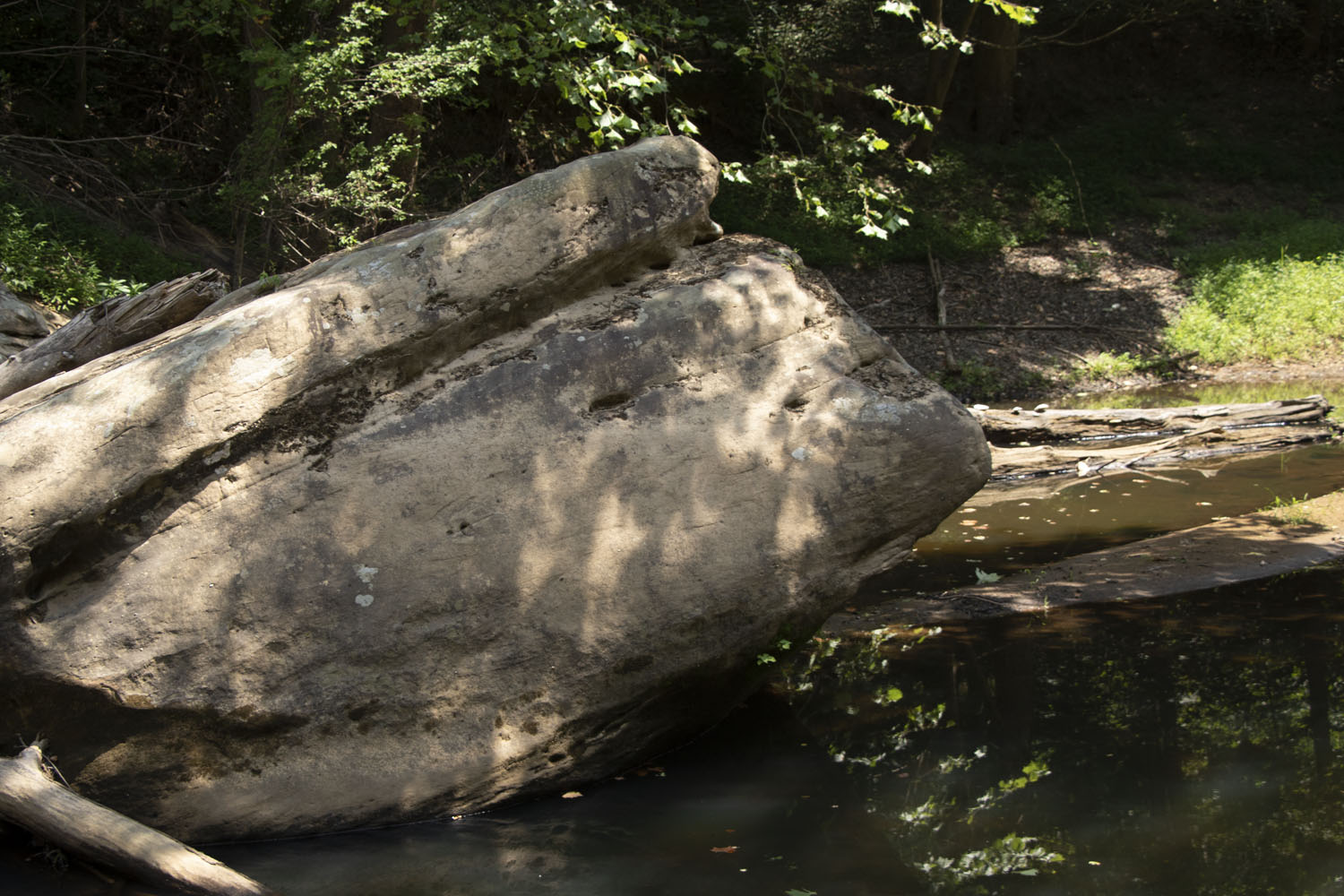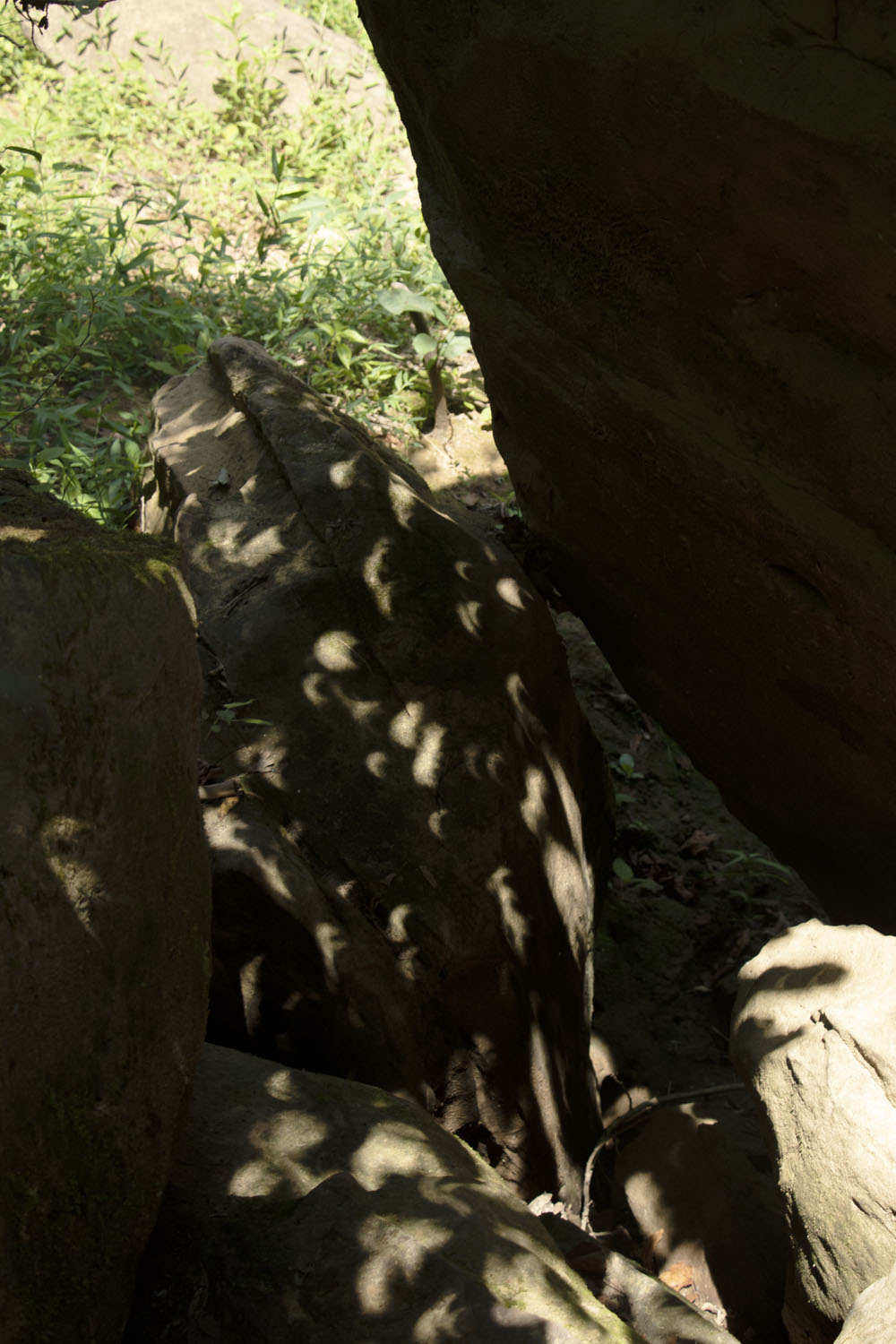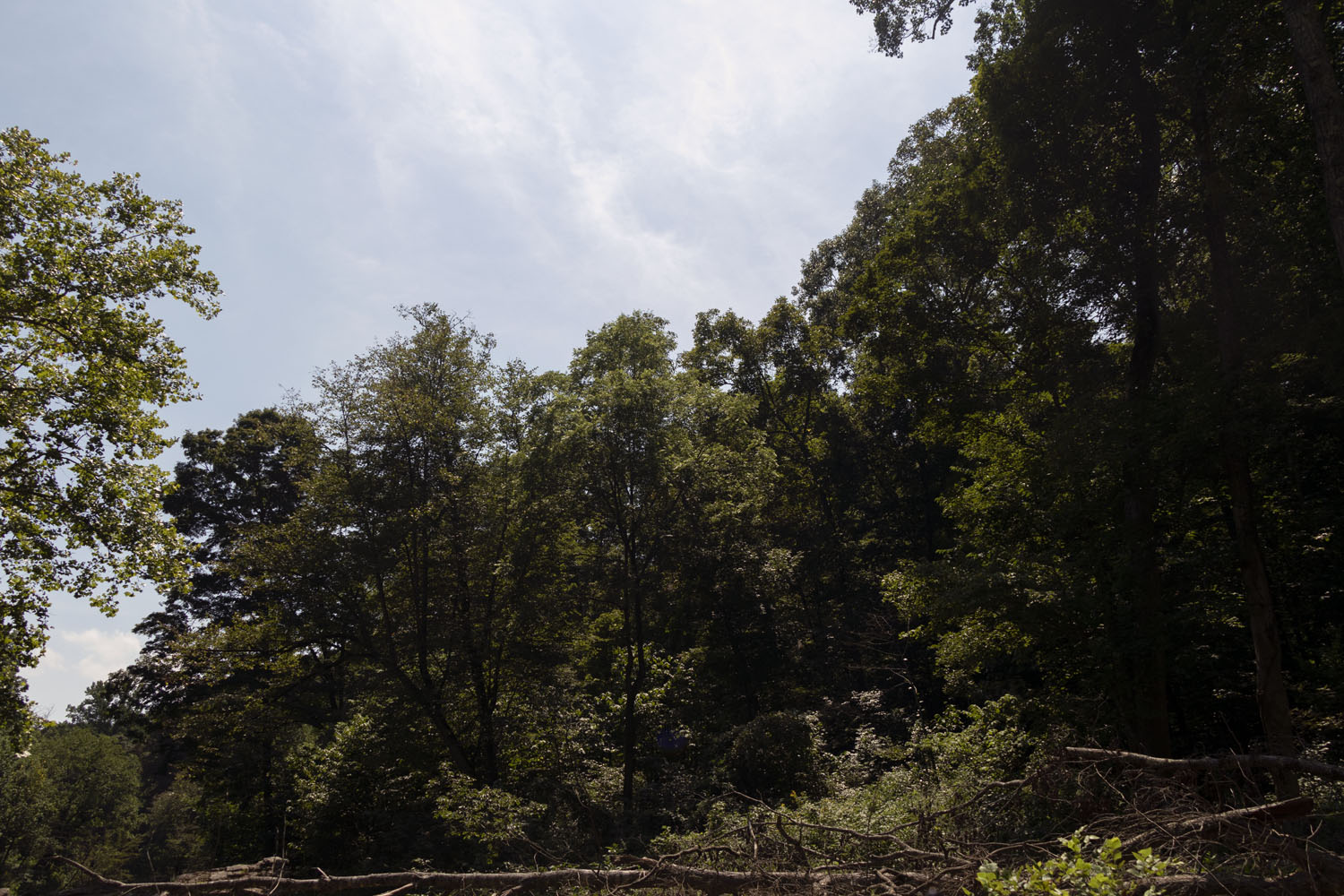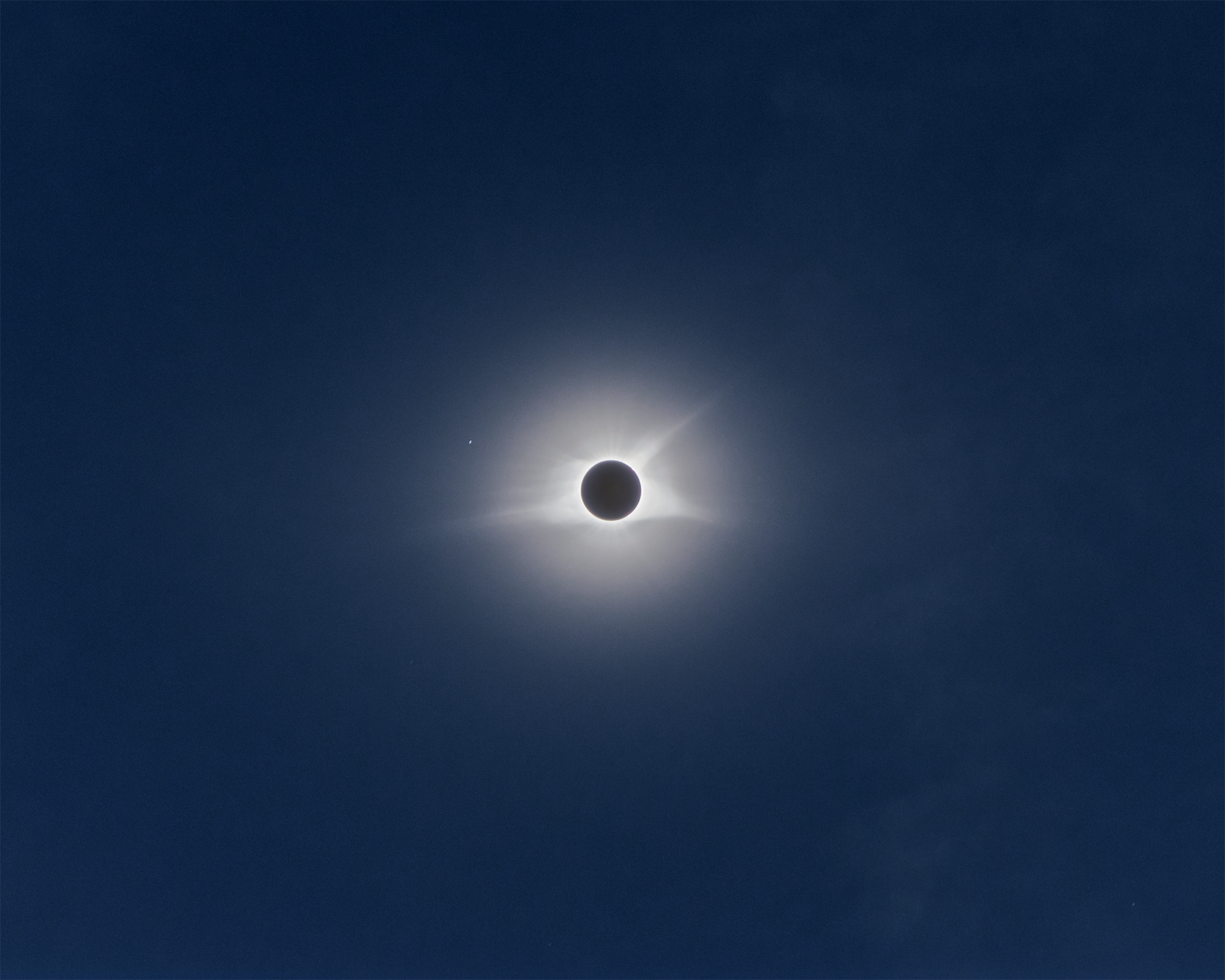Although the eclipse began shortly before noon, it wasn't until a little after noon before I could see a small bite starting to appear out of the corner of the Sun through my eclipse glasses. Seeing the first signs of what to come snapped the morning malaise and established a flow to events. Things felt like they were moving a little more quickly. As the Sun became half covered, I noticed my gamble with the weather was paying out - most of the smaller puffs were starting to dissipate, and some of the puffs that had started towering were quickly losing their energy. The only remaining weather concern was a pair of towers along the southern horizon, which seemed to have established themselves enough that they didn't need continued heating to keep going. Although they were well off in the distance, I was worried about the anvils they were producing. They weren't being sheared off, but were instead growing in all directions - or at least as far as I could see my direction. I was worried that they might continue expanding my way. There was also a chance for something to emerge from the trees to my east, as I held tight all I ever saw drift into view were quickly evaporating puffballs.
With my concern about the weather easing, I switched my attention from the clodus and to the changes occurring with the eclipse. After about 12:30, the light began taking on an odd quality. Everything seemed to be coming into sharper focus, but the lighting was clearly diminished.

The wildlife, too, was taking notice. All morning a large colony of cliff swallows had kept me company as they swooped along the creek to hunt insects. Their cacophony of hunting chirps and alarm cries which had filled the morning air were shifting to cackles of nesting chatter. Other birds, which had contributed their own calls to the symphony of noise, began to quiet. The cicadas changed from their tune from sporadic evening buzz to the gentle waves of evening song. Finally, the crickets emerged, followed shortly by the chirps of frogs. All told it took only 15-20 minutes for afternoon activities to transition to evening activities.
Shortly before 1pm, I decided to make last rounds for nature photography before setting up the Canon for totality. At this point the landscape was starting to change by the minute, and the afternoon heat was starting to break. It was a welcome relief! As I strolled around the campsite, I stumbled across a magical spot where pinhole lights were falling onto a small shelter between boulders. It felt almost like a petroglyph site, where someone had scrawled crescents over one single rock in particular, but with the rock writing attached to delicate sunbeams filtering through the trees. I wondered if other petroglyph sites were designed to reproduce, however dimly the most skilled human hands can recreate such a site, this mystical connection between sky and earth. I spent a lot of my remaining time trying to get a photo that captured the sunbeams, but to no avail. It was as much a sight as much of mind as it was of vision.

By the time I gave up on trying to capture the sight of the crescent-speckled rock face, I noticed that the pinhole crescents were everywhere around me. Even the largest blobs of light were morphing into something suggesting a crescent. The light was quickly fading, making it more and more difficult to get pictures of the increasingly spectacular landscape. As I wandered back over to my campsite, I found pinhole images of the Sun falling into the murky creek, forming dim highlights swarming with minnows, connected by sunbeams to a dimmer highlight on the water surface. I have never seen a creek appear more three-dimensional than it did in that moment. I came across pinhole images of the Sun falling into the murky creek, but trying to capture the crescent beams falling through the murk proved to be impossible.
About 10 minutes before totality, the lighting adopted a truly bizzare quality. Areas getting full sunlight weren't much brighter than the shadows. Everything appeared razor sharp, but the pinhole crescents fluttering around in a strengthening "evening" breeze made everything appear to shimmer. The landscape was awash in a dull orange-red glow, as if it were colored by a purpose filtered stage light. I tried to get a photo of the landscape, but like many of the other photos I took, it did not truly capture the ethereal movement of the landscape around me.

The last photo I took before putting the Canon on the tracking mount was of my shadow, which probably best captures the dull orange glow and distortions of the shadows. Looking at it again I can partially see what was weirding me out about the light - some shadow edges are razor sharp while others are blurry. I assume this is because of the crescent shape of the light source, since the light source is very wide in one direction and very narrow in another.

Feeling a bit behind schedule and mesmerized by the scene around me, I quickly set up my camera. The light continued to get stranger and stranger, with the landscape becoming increasingly saturated in orange, continuing to sharpen even as it faded from view. Looking up, I could see that despite the orange appearance of the landscape around me, the skies had turned deep blue with a slightly purple tint. Then, just before totality (no more than 30 seconds before it started), the landscape came alive in a different way. Shadow bands! Small ones only a few inches across flickered across the rock under me, and looking around I saw large ones that must have been a few feet across rolling across boulders sitting in the creek. I was transfixed by the sight, when suddenly, my phone let out two large chirps to let me know totality was imminent. I took a big gulp and tried to break my attention from the roiling landscape.
My hands were shaking with a mixture of amazement and excitement. I immediately fumbled the lens cap, and it took a moment for me to even realize what had happened. I was having a hard time keeping track of the time, even with my phone now reading off a countdown to totality. What caught my attention just long enough to refocus me was visibly seeing the diamond ring starting to form, which reminded me to start my first photographic sequence.

It was hard to imagine it getting any darker given how much of the Sun was covered, but as soon as the last drip of sunlight was sucked up behind the Moon the landscape grew truly dark. The sudden plunge into darkness almost triggered a panic response, and I could feel the terror welling up deep inside me. I immediately understood the ancient anxieties and traumas associated with a solar eclipse. The Sun was a bright silver ring, hyper polished, which surrounded a pitch black disk. It seemed to loom over the landscape. The large wings of the corona unfurled around it, resembling a misshapen butterfly. The skies were a faint indigo in color, and the thin cirrus that was starting to drift over had a mother-of-pearl appearance, soft and milky white near the sun, going through the colors of the sunset in every direction. It was an ominous sight, a sudden transplant into a liminal space.
I stared for what felt like minutes, but in reality was only about 20 to 30 seconds. A light bulb kicked on in my brain and I remembered to flip to the next sequence. Although I was hoping to take 7 or 8 HDR sequences during the eclipse, I only managed four. The rest of the time I spent basking in the landscape. As I adjusted to the sight the panic response began to subside, and I started noticing smaller details in the world around me. The thunderstorm towers to the south were starting to darken as they entered eclipse, and it was fascinating to watch them turn a dull gray as the red-purple sky glow intensified behind them. Partway through I noticed a plane cross nearly overhead flying southeast, which must have been one of the NASA research jets flying along the centerline.

I remembered that I had binoculars, but it turns out my hands were shaking too much to actually use them. I do remember spotting a couple of small prominences in the 4 o'clock position, but otherwise the field of view was jumping around too much to focus on anything. So I put the binoculars back down and leaned back in my chair to take in the sight. Suddenly, there was another chirp from my phone - totality was almost over. By this point I had mostly regained my composure, and didn't fumble around as much to get the photos I wanted. I started my last sequence only a couple of seconds before the diamond ring reappeared.
The end of totality was beautful. Unlike the entrance to totality, where the diamond ring formed and disappeared almost instantly, the exit lingered for a few moments. A small spot of sunlight slipped out from behind the moon, almost like a drip hanging on a faucet. The silvery beacon sat there alone for a few seconds, before suddenly a torrent of sunlight flooded over the landscape. Excited, I began to look around for the shadow bands that had so mesmerized me prior to totality. But unlike the multitude of differently-sized bands that had roiled my surroundings in a unified direction before the eclipse in a unified direction, there were only small, faint bands which moved chaotically and disappeared quickly.

As the bands faded from view, I looked to the thunderstorm turrets to the south, which were now reemerging from the Moon's shadow. Now in bright sunset colors, stood out against the dim indigo skies behind them. By this point I was completely overwhelmed, and sat shaking from happiness at the experience.